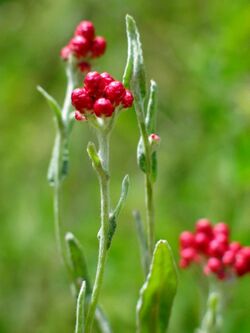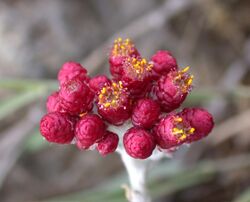Biology:Helichrysum sanguineum
| Helichrysum sanguineum | |
|---|---|

| |
| Scientific classification | |
| Kingdom: | Plantae |
| Clade: | Tracheophytes |
| Clade: | Angiosperms |
| Clade: | Eudicots |
| Clade: | Asterids |
| Order: | Asterales |
| Family: | Asteraceae |
| Genus: | Helichrysum |
| Species: | H. sanguineum
|
| Binomial name | |
| Helichrysum sanguineum (L.) Kostel
| |
Helichrysum sanguineum, known in English as red everlasting and red cudweed, is a flowering plant of the genus Helichrysum in the family Asteraceae.[1] It grows in mountain forests in the Levant where it blooms in April–June.[1][2] The flower, known in Hebrew as "Blood of the Maccabees", has become the icon of Yom Hazikaron, Memorial Day for Israel's Fallen Soldiers and Victims of Terrorism.[1]
Name
Helichrysum sanguineum (L.) Kostel is not to be mistaken for Helichrysum sanguineum Boiss. = Gnaphalium sanguineum L., which is known in English as sowbread[3] or cyclamen.
In Arabic, the flower is known as "دم المسيح" (dam al-Massiah), meaning "blood of the Messiah"/"blood of Christ".
In Hebrew, it is known as "blood of the Maccabees" (Hebrew: דם המכבים, dam hamakabim). The name is derived from a legend saying that in every spot where the flower grows, a drop of blood has spilled on the earth.[1]
History
The Hebrew name Dam hamakabim was coined by the botanist Ephraim Hareuveni in 1917. The symbolic connection to Israeli war casualties first appeared in a poem by Haim Gouri written in memory of 35 Palmach comrades killed in January 1948.[4] Since 2019, the non-profit organization Dam HaMaccabim has been distributing pins with the flower throughout Israel.[5][6]
Distribution
The plant grows in the Levant, including: western Syria,[7] the Mediterranean coast of Lebanon and Mount Lebanon up to an altitude of 1000 m,[8] on the Golan Heights, in most of the northern and central part of Israel and the West Bank (Upper and Lower Galilee, around the Sea of Galilee, on Mount Carmel and the Coastal Plain south of it, Mount Gilboa, the northern part of the Jordan Valley, Samaria, the Judean mountains and the Shefela), and the mountainous Gilead region in Jordan[9] (the areas of Jarash and Dibeen, Ajloun, and Al-Salt).[2]
In Israel, Helichrysum sanguineum is a endangered species.[10]
See also
- Wildlife in Israel
- Flora of Lebanon
References
- ↑ 1.0 1.1 1.2 1.3 Flowers in Israel
- ↑ 2.0 2.1 helichrysum sanguineum - Red everlasting, Royal Botanic Garden, Jordan. Accessed April 2020.
- ↑ Crawford H. Greenewalt, jr., Lydian Cosmetics, Sardis Expedition: Archaeological Exploration of Sardis, accessed April 2020
- ↑ How a Wildflower Became a Symbol for Israel’s Memorial Day
- ↑ Yaafa Abadi, "The Dam HaMaccabim Project Blossoms In Time For Yom Hazikaron", The Jerusalem Post
- ↑ Mordechai Sones, "Red Everlasting: 'Blood of the Maccabees' flower sticker comes to life", Arutz Sheva
- ↑ Helichrysum sanguineum (L.) Kostel, JSTOR Global Plants, accessesd April 2020
- ↑ Helichrysum sanguineum (L.) Kostel, Lebanon FLORA, accessesd April 2020
- ↑ Helichrysum sanguineum (L.) Kostel, Flowers of Israel Online, Prof. Avinoam Danin, accessesd April 2020
- ↑ "אכרזת גנים לאומיים, שמורות טבע, אתרים לאומיים ואתרי הנצחה (ערכי טבע מוגנים) – ויקיטקסט" (in he). https://he.wikisource.org/wiki/%D7%90%D7%9B%D7%A8%D7%96%D7%AA_%D7%92%D7%A0%D7%99%D7%9D_%D7%9C%D7%90%D7%95%D7%9E%D7%99%D7%99%D7%9D,_%D7%A9%D7%9E%D7%95%D7%A8%D7%95%D7%AA_%D7%98%D7%91%D7%A2,_%D7%90%D7%AA%D7%A8%D7%99%D7%9D_%D7%9C%D7%90%D7%95%D7%9E%D7%99%D7%99%D7%9D_%D7%95%D7%90%D7%AA%D7%A8%D7%99_%D7%94%D7%A0%D7%A6%D7%97%D7%94_(%D7%A2%D7%A8%D7%9B%D7%99_%D7%98%D7%91%D7%A2_%D7%9E%D7%95%D7%92%D7%A0%D7%99%D7%9D).
External links
Wikidata ☰ Q2910998 entry
 |


